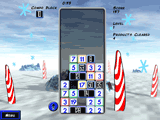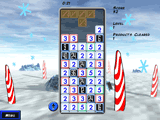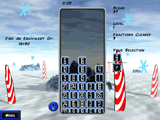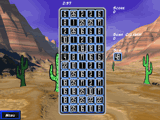About Prime Time
Prime Time: Math Adventure is a math-based puzzle game that is actually FUN! There are many math-based games on the market, but few engage the student. Prime Time provides the benefits of educational software in a package enjoyable for both students and gamers. While the material targets grades 3 through 7, children and adults of all ages find it entertaining.
Prime Time offers different play modes that allow the program to be modified to fit different skill and grade levels. Prime Time's features include:
- 8 difficulty levels that allow the software to be tailored to the user's mathematics acumen.
- 4 different play types that provide exercise in skills like strategy or quick thinking in addition to math.
- For the first time in educational software, the ability for students to compete on-line against students all over the world is available.
- The ability to analyze a student's activity and generate custom exercises that focus on his or her weaknesses.
- An auto-update tool that allows for expansion of Prime Time's features at no additional cost.
Play Modes
Combos
When you clear a product, all of the other products around the cleared one will become "comboable." Comboable products are indicated with a TV-static like border around the block. Every time a comboable product is cleared you increase a score multiplier that gets applied whenever points are earned. If you clear a non-comboable product or make a mistake when clearing a product then your multiplier is reset to 1. Combo blocks should be used by advanced players when trying to get #1 on the high score table.
Mobile
Prime Time is available for your Android or Apple mobile device. The mobile version offers the classic mode gameplay, high score competition with occasional contests, and tutorials to help you master your skills. You can get it from the Android Marketplace, Apple App Store, or the Amazon App Store.
Learning Assistance
Players have the option of logging in before playing a game. Creating a user profile provides the convenience of remembering a player's game settings, but provides the more important service to tracking all of the user's play time. The player's activity can be used to calculate where he or she has the most difficulty. For example, Prime Time will be able to figure out if a player always has a problem using the prime factor 11. This information can then be used in the "Help me Learn" play mode.
Prime Time: Math Adventure provides an option on the main menu called "Help Me Learn". Here the player can find "1-Minute Tutorials" on how to play and improve his or her game, practice mode, and "Improve my Skills" mode. "1-Minute Tutorials" provide super fast and clear instructions about how to play the game and how to perform advance techniques. Practice mode allows the player to fully customize a game of Prime Time mode gameplay to work on what they see as weaknesses.
The "Improve My Skills" mode is a very important feature for the Prime Time. Many educational games on the market do not provide any feedback about how a student is doing. Of the very few that do, only two currently available can customize the content for the user, and both of these programs require teacher input. Prime Time uses the information gathered while a player plays while logged in and can actually present a round of gameplay that will focus on the areas where the player makes the most mistakes.
Who made Prime Time?
Prime Time was created by Taylor Clark and Ben Shirley. A successful math student in high school (Connecticut Academic Performance Test Award - Mathematics 1998), Taylor completed 4 years at DigiPen Institute of Technology. The rigorous program led to his first job at Monolith Productions, Inc. Taylor's credits include the award-winning Mall Monster and epic The Matrix Online.
Ben Shirley's background in interactive entertainment is just as accomplished. Ben's credits include Lego Star Wars 2, Rogue Ops, and The Chronicles of Narnia video game. Ben's simple yet engaging program layout (the look of the software) makes the game attractive to students who might be turned off by the thought of educational software.
During Taylor's mentoring session with a middle school student he realized there were no educational games young students looked forward to playing. While in school, Ben and Taylor enjoyed playing such math games as Number Munchers1. Recognizing the void in current entertaining educational software, Ben and Taylor decided to make a game students would love to play yet that would still provide a learning experience.
Minimum Computer Requirements
- Windows XP SP2 or later
- A resolution of 1024x768 capable monitor and graphics adapter
- Pentium 3 500MHz
- 32MB RAM
- 65MB Hard disk space
1. Number Munchers is property of MECC.








